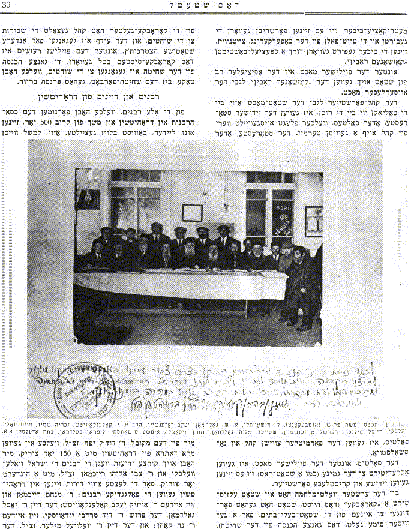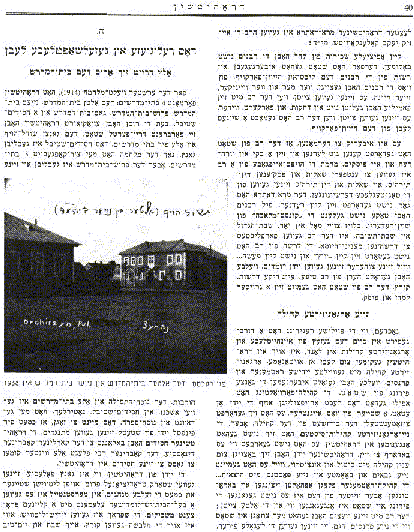Previous Page
|
Next Page
 [
Page 39
]
[
Page 39
]
the community's vital statistics records, where the births and deaths of the
residents were recorded. In addition, the records were handled by a specially
appointed "administrative rabbi" [kozheniy rabbin].
Under the Polish regime, the
official rabbi of the town was also the "administrative rabbi" in
relation to outside authorities. The community representative to the city
authorities, both under the Russian and Polish regimes, was the Jewish Elder,
who was appointed by the community for a specified term of office. The Elder
was the liaison between the community and the local government officials.
Under the Polish regime, the
Elder was accredited to the city council, which included both Jewish and
Christian representatives. Prior to the First World War, there was a
korobka
account (i.e. the city leased all the income from animal slaughter to one of
the local businessmen for a specific amount of money). The money contained in
the
korobka
account covered the costs of paying slaughterers, and whatever was left was
used to pay for other local needs. Under the Polish regime this system was
terminated. All income derived from animal slaughter went directly to the
slaughterers, who earned a good living until the ban on kosher slaughter.
[Photo:] Seated, from right: Moshe Porush, unknown, L. Mishovsky, A. S.
Goldman, Yaakov Rosenstein, Rabbi A. I. Kalenkovitch, Zechariah Schmid, Chaim
Volevelsky, Chaikel Milner, Hershel Eisenstein. Standing: Eliyahu Goldman,
Nachman Wisotsky, Itshe M. Shavsky, Lipman Feldman, Zemach Odelsky, et al.
[The handwritten text is as is legible:] On the occasion of the journey of our
esteemed and honest member who is involved in the community needs of our city,
[illegible] Chaikel Milner, to our holy land. As a token of thanks and a
souvenir, we are giving him a set of the Talmud from Drohitchin [illegible] and
the picture. We bless his and all his family that they merit to witness the
arrival of the Messiah speedily in our days.
[Illegible] The Rabbi, [names illegible]
Rabbis and rabbinical court judges in Drohitchin
Unfortunately, we know very
little about the men who held the position of community rabbi in Drohitchin
over a period of almost 500 years. For example, we know about the kabbalist,
Rabbi Dovidel Yaffe, who was the community rabbi of Drohitchin 150 years ago.
We also know a few details about rabbis Yisrael Valevelsky and Zvi Eliyahu
Reichman who lived a century ago. The following rabbis served in Drohitchin in
the last three generations: Rabbi Menachem Reichman and his son-in-law, R.
Isaac Yaakov Kalenkovitch; the rabbinical court judge, Rabbi Yossel Goldman;
the scholar, Rabbi David Mordechai Yudovsky, and his son-in-law, R. Noach Kahn,
and finally, the rabbinical court judge, Rabbi Velvel Miller. The
 [
Page 40
]
[
Page 40
]
last community rabbi of Drohitchin was Rabbi Isaac Yaakov Kalenkevitch, may G-d
avenge his blood!
The rabbis never received
official salaries. Therefore, the town gave the rabbis the authority over the
sale of candles and yeast, which provided them with a livelihood, some a
greater livelihood and others a smaller one. There were times when a community
rabbi and his family experienced hardship, and other times when a rabbi made a
good living from the yeast business.
It goes without saying that the
rabbi of the town had to be well-learned and well-versed in Jewish law. Due to
the important tasks of being a rabbi, answering Jewish legal questions and
participating in rabbinical court cases was a daily event. The community rabbi
didn't have to be a public speaker. In fact, many rabbis weren't adept at
public speaking. The rabbi would speak publicly only twice a year - on the
Sabbaths before Passover and Yom Kippur. His speech wasn't supposed to be
humorous or to involve story-telling, since his audience was learned Jews
themselves who wanted their rabbi to speak about profound relevant issues. In
short, the rabbi of town had to be a great scholar and decisor of Jewish legal
problems.
The reorganized community
Later on, the Polish government
passed a law in the Polish parliament regarding the re-organization of Jewish
communities in Poland, including that of Drohitchin, of course, which became
into an autonomously organized community, with elected Jewish council members
and officials, who took over the administration of the town. The community
council even had the right to impose a tax on the Jews, which was intended to
pay for the budget of the community. The re-organized community system,
however, wasn't well-received in Drohitchin, and didn't function the way it
supposed to. The attitude of Jews in Drohitchin to the idea of a community
organization was one of contempt and mistrust, because it meant new officials
and positions to fill, which had to be financed. The community council members
would hold meetings and vote, but didn't do much more than that. The
administration of the community continued as it had earlier. The rabbi and his
advisors exerted more influence than the new officials in town, even though the
officials were the legal administrators.
[Photo:] From right: the old House of Study and the new one in 1938.
5.
RELIGIOUS AND SOCIAL LIFE
Everything centered around the House of Study
[
trans
. It should be noted that the terms "synagogue" and "House of
Study" are historically basically interchangeable. Strictly speaking,
however, a synagogue is where only prayers are held, whereas a House of Study
is where Jewish men also engage in religious study. Usually a
"synagogue" would be furnished with rows of pews, whereas a
"House of Study" would have tables and chairs/benches instead.]
Before World War I (1914), there were four Houses of Study in Drohitchin: the
old House of Study, the new one, the Scholars' House of Study, the Street House
of Study and a chassidic
shtibel
[small one-room synagogue]. When the Russians evacuated Drohitchin, they burned
down three-quarters of the town, the synagogue courtyard and all four Houses of
Study. Only the chassidic remained untouched. After the war, the three Houses
of Study were rebuilt, but the Scholars' House of Study was not rebuilt. The
version of the prayers in the Houses of Study was
Ashkenaz,
while the chassidim prayed according to the
Sephard
version. This means that about 80% of the Jews in Drohitchin were not
chassidim. The Drohitchin chassidim belonged to the Karlin-Kobrin dynasty of
rebbes. Every winter, the Kobrin rebbe would come to Drohitchin to stay with
his chassidim for a visit.
The Jews of Drohitchin, as in
the rest of Polesia, were very traditionally religious in the Lithuanian
manner, and followed almost the same customs. The population was mostly made up
of Jews who were scholarly and householders, while a small number were
modernized followers of the Enlightenment. The people spoke Lithuanian Yiddish
and wore short jackets. On the Sabbath and the holidays,
Previous Page
|
Next Page
This material is made available by JewishGen, Inc.
and the Yizkor Book Project for the purpose of
fulfilling our
mission of disseminating information about the Holocaust and
destroyed Jewish communities.
This material may not be copied,
sold or bartered without JewishGen, Inc.'s permission. Rights may be
reserved by the copyright holder.
JewishGen, Inc. makes no representations regarding the accuracy of
the translation. The reader may wish to refer to the original material
for verification.
JewishGen is not responsible for inaccuracies or omissions in the original work and cannot rewrite or edit the text to correct inaccuracies and/or omissions.
Our mission is to produce a translation of the original work and we cannot verify the accuracy of statements or alter facts cited.
 Drogichin, Belarus
Drogichin, Belarus
 Yizkor Book Project
Yizkor Book Project
 JewishGen Home Page
JewishGen Home Page
Yizkor Book Director, Lance Ackerfeld
This web page created by Lance Ackerfeld
Copyright © 1999-2025 by JewishGen, Inc.
Updated 7 Dec 2001 by LA
 [
Page 39
]
[
Page 39
]



